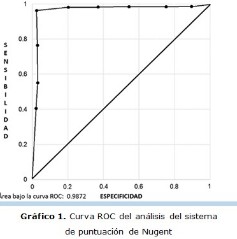Effectiveness of the Nugent Score System in the diagnosis of bacterial vaginosis
Keywords:
Vaginosis bacteriana, criterios de Amsel, prueba de Nugent, infección vaginal, diagnóstico.Abstract
Background: the bacterial vaginosis is the commonest cause of vaginal infection.
Objective: to establish the diagnostic effectiveness of the Nugent test in the bacterial vaginosis diagnosis.
Methods: a transversal study of evaluation of diagnostic tests in a universe of 26 patients diagnosed with bacterial vaginosis according to the Amsel criteria, in the the "Luis Enrique de la Paz Reyna" clinic in Yara, Granma. Age, risk factors, results of the perspired vaginal and results of the Nugent test were identified.
Results: from 26 patients diagnosed with bacterial vaginosis the average age was 29, 31 years. The most found risk factor was the inadequate genital toilet technique (76,92 %). The perspired vaginal result gave positive to Gardenella vaginalis in 88,47 %. The analysis of the results of the Nugent test, by means of the construction of the ROC curve, was in under the curve area of 98,72 % (IC 95 %: 95,83 %; 100 %), with standard error of 0,0083.
Conclusions: the bacterial vaginosis is diagnosed mainly in very young adults, taking into account the inadequate techniques of toilet, being the main risk factor. A high percentage of Gardenella vaginalis positive cultivations was obtained. The Nugent punctuation system resulted in a test with a high diagnostic capacity.
DeCS: VAGINOSIS, BACTERIAL; DIAGNOSTIC TESTS, ROUTINE; RISK FACTORS; ADULT; CROSS-SECTIONAL STUDIES.
Downloads
References
1.Pérez Pérez OF. De los Albores a los albores: un recorrido por la historia de la medicina [Internet]. La Habana: Editorial Ciencias Médicas; 2011 [citado 14 Dic 2016]. Disponible en: http://www.bvs.sld.cu/libros/de_los_albores/de_los_albores_completo.pdf
2.Puentes Rizo EM, Enríquez Domínguez B, Jiménez Chacón MC, López Rodríguez P. Comportamiento del Síndrome de flujo vaginal en el Consultorio 16, Policlínico Párraga. Rev Cubana Obstet Ginecol [Internet]. Sep 2009 [citado 14 Dic 2016];35(3):[aprox. 14 p.]. Disponible en: http://scielo.sld.cu/scielo.php?script=sci_arttext&pid=S0138-600X2009000300007&lng=es
3.Morales Parra GI. Aspectos clínicos y diagnóstico de laboratorio de la vaginosis bacteriana. Rev haban cienc méd [Internet]. Oct 2015 [citado 16 Dic 2016];14(5):[aprox. 12 p.]. Disponible en: http://scielo.sld.cu/scielo.php?script=sci_arttext&pid=S1729-519X2015000500008&lng=es
4.Camargo KC, Figueiredo Alves RR, Baylão LA, Alves Ribeiro A, Alves de Souza Araujo NL, Brito do Nascimento Tavares S, et al. Secreção vaginal anormal: Sensibilidade, especificidade e concordância entre o diagnóstico clínico e citológico. Rev Bras Ginecol Obstet [Internet]. May 2015 [citado 16 Dec 2016];37(5):[aprox. 9p.]. Disponible en: http://www.scielo.br/scielo.php?script=sci_arttext&pid=S0100-72032015000500222&lng=en
5.Mejía Pérez D, Ángel Müller E, Rodríguez Hernández AE, Ruiz Parra AI, Tolosa Ardila JE, Gaitán Duarte H. Características operativas del diagnóstico clínico con y sin pruebas de consultorio (ph y pruebas de aminas) para el diagnóstico de vaginosis bacteriana, en pacientes sintomáticas en Bogotá, Colombia. Rev Colomb Obstet Ginecol [Internet]. Dic 2015 [citado 16 Dic 2016];66(4):[aprox. 10 p.]. Disponible en: http://www.scielo.org.co/scielo.php?script=sci_arttext&pid=S0034-74342015000400004&lng=en
6.Rigol Ricardo O, Santiesteban Alba SR. Obstetricia y Ginecología [Internet]. La Habana: Editorial Ciencias Médicas; 2011 [citado 16 Dic 2016]. Disponible en: http://www.bvs.sld.cu/libros_texto/ginecologia_obstetricia_3raedicion/indice_p.htm
7.Tafner Ferreira CS, Marconi C, García Parada CML, Cassamassimo Duarte MT, Oliveira Gonçalves AP, Cunha Rudge MV, et al. Bacterial vaginosis in pregnant adolescents: proinflammatory cytokine and bacterial sialidase profile. Cross-sectional study. Sao Paulo Med J [Internet]. 2015 Dec [citado 2017 Jan 6];133(6):[about 5 p.]. Available from: http://dx.doi.org/10.1590/1516-3180.2014.9182710
8.De Freitas Paganoti C, Bittar RE, Burlacchini de Carvalho MH, Vieira Francisco RP, Zugaib M. As infecções genitais podem alterar os resultados dos testes preditivos do parto prematuro? Rev Bras Ginecol Obstet [Internet]. Jan 2015 [citado 16 Dec 2016];37(1):[aprox. 15 p.]. Disponible en: http://www.scielo.br/scielo.php?script=sci_arttext&pid=S0100-72032015000100010&lng=en
9.Vera C LM, López BN, Arámbula AL. Validez y reproducibilidad del sistema de puntuación de Nugent para el diagnóstico de Vaginosis bacteriana en mujeres embarazadas. Rev Chil Obstet Ginecol [Internet]. 2009 [citado 4 Jun 2016];74(5):[aprox. 5 p.]. Disponible en: http://www.scielo.cl/scielo.php?script=sci_arttext&pid=S0717-75262009000500004&lng=es&nrm=iso&tlng=es
10.Faure E, Faure K, Figeac M, Kipnis E, Grandjean T, Dubucquoi S, et al. Vaginal Mucosal Homeostatic Response May Determine Pregnancy Outcome in Women With Bacterial Vaginosis. Medicine [Internet]. 2016 Feb [citado 2016 Dec 16];95(5):[about e2668 p.]. Available from: 10.1097/MD.0000000000002668
11.Martínez Martínez W, Calderón Badía B, Cruz Lage L. Comparison of diagnostic methods for bacterial vaginosis. Afr J Microbiol Res [Internet]. 2014 [citado 2016 Dec 16];8(12):[about 7 p.]. Available from: http://www.academicjournals.org/journal/AJMR/article-abstract/789042246421
12.Cartwright CP, Lembke BD, Ramachandran K, Body BA, Nye MB, Rivers CA, et al. Comparison of nucleic acid amplification assays with BD affirm VPIII for diagnosis of vaginitis in symptomatic women. J Clin Microbiol. 2013;51(11):3694-9.
13.Cardona Arias JA, Herrera Posada D, Valencia Arredondo M. Prevalencia de resultado positivo de la citología para vaginosis bacteriana, candidiasis y tricomoniasis en una Empresa Social del Estado de Medellín (Colombia), 2010-2012. Rev Colomb Obstet Ginecol [Internet]. Sep 2014 [citado 16 Dic 2016];65(3):[aprox. 8 p.]. Disponible en: http://www.scielo.org.co/scielo.php?script=sci_arttext&pid=S0034-74342014000300002&lng=en
14.Nugent RP, Krohn MA, Hillier SL. Reliability of diagnosis bacterial vaginosis is improved by a standardized method of gram stain interpretation. J Clin Microbiol. 1991;29(2):297-301.
15.Arnold Rodríguez M, González Lorenzo A, Carbonell Hernández T. Diagnóstico de Vaginosis bacteriana. Aspectos clínicos y estudios microbiológicos. Rev Med Electrón [Internet]. May-Jun 2014 [citado 16 Feb 2015];36(3):[aprox. 14 p.]. Disponible en: http://scielo.sld.cu/scielo.php?script=sci_arttext&pid=S1684-18242014000300009&lng=es
16.Mejía Pérez D, Ángel Müller E, Rodríguez Hernández AE, Ruiz Parra AI, Tolosa Ardila JE, Gaitán Duarte H. Características operativas del diagnóstico clínico con y sin pruebas de consultorio (ph y pruebas de aminas) para el diagnóstico de vaginosis bacteriana, en pacientes sintomáticas en Bogotá, Colombia. Rev Colomb Obstet Ginecol [Internet]. Dic 2015 [citado 6 Ene 2017];66(4):[aprox. 9 p.]. Disponible en: http://www.scielo.org.co/scielo.php?script=sci_arttext&pid=S0034-74342015000400004&lng=pt
17.López Torres L, Chiappe M, Cárcamo C, Garnett G, Holmes K, García P. Prevalencia de vaginosis bacteriana y factores asociados en veinte ciudades del Perú. Rev perú med exp salud pública [Internet]. Jul 2016 [citado 21 Ene 2017];33(3):[aprox. 8 p.]. Disponible en: http://www.scielo.org.pe/scielo.php?script=sci_arttext&pid=S1726-46342016000300009&lng=es&nrm=iso
18.Arnold Rodríguez M, González Lorenzo A, Carbonell Hernández T. Diagnóstico de vaginosis bacteriana. Aspectos clínicos y estudios microbiológicos. Rev Med Electrón [Internet]. Jun 2014 [citado 6 Abr 2017];36(3):[aprox. 14 p.]. Disponible en: http://scielo.sld.cu/scielo.php?script=sci_arttext&pid=S1684-18242014000300009&lng=pt
19.Workowski KA, Berman S. Centers for Disease Control and Prevention (CDC). Sexually transmitted disease treatment guidelines, 2010. MMWR Recomm Rep. 2010;59:1-110.
20.Nyirsjesy P. Manejo de Vaginitis Persistente. Obstet Gynecol. 2014;124:1135-46. 21.Zemenu M, Yimtubezinash W, As rat D, Yigeremu M. Comparison of Clinical and Gram Stain Diagnosis Methods of Bacterial Vaginosis Among Pregnant Women in Ethiopia. J Clin Diag Res. 2013;7(12):2701-2703.

Published
How to Cite
Issue
Section
License
Copyright: Camagüey Medical Archive Magazine, offers immediately after being indexed in the SciELO Project; Open access to the full text of the articles under the principle of making available and free the research to promote the exchange of global knowledge and contribute to a greater extension, publication, evaluation and extensive use of the articles that can be used without purpose As long as reference is made to the primary source.
Conflicts of interest: authors must declare in a mandatory manner the presence or not of conflicts of interest in relation to the investigation presented.
(Download Statement of potential conflicts of interest)
The Revista Archivo Médico de Camagüey is under a License Creative Commons Attribution-Noncommercial-No Derivative Works 4.0 International (CC BY 4.0).
This license allows others to distribute, to mix, to adjust and to build from its work, even for commercial purposes, as long as it is recognized the authorship of the original creation. This is the most helpful license offered. Recommended for maximum dissemination and use of licensed materials. The full license can be found at: https://creativecommons.org/licenses/












 22 julio 2025
22 julio 2025